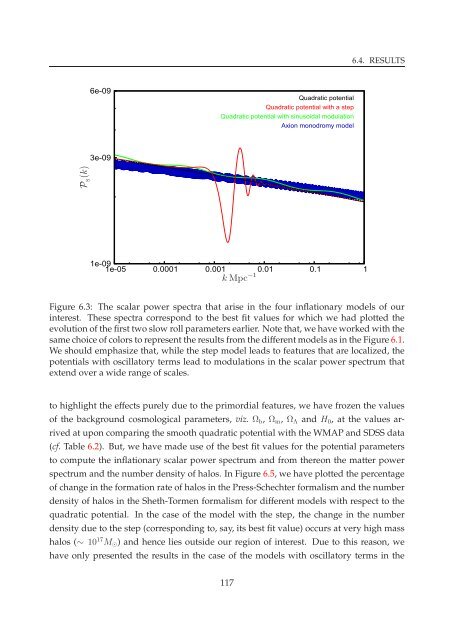PHYS08200605006 D.K. Hazra - Homi Bhabha National Institute
PHYS08200605006 D.K. Hazra - Homi Bhabha National Institute
PHYS08200605006 D.K. Hazra - Homi Bhabha National Institute
You also want an ePaper? Increase the reach of your titles
YUMPU automatically turns print PDFs into web optimized ePapers that Google loves.
6.4. RESULTS<br />
6e-09<br />
Quadratic potential<br />
Quadratic potential with a step<br />
Quadratic potential with sinusoidal modulation<br />
Axion monodromy model<br />
3e-09<br />
P S<br />
(k)<br />
1e-09 1e-05 0.0001 0.001 0.01 0.1 1<br />
kMpc −1<br />
Figure 6.3: The scalar power spectra that arise in the four inflationary models of our<br />
interest. These spectra correspond to the best fit values for which we had plotted the<br />
evolution of the first two slow roll parameters earlier. Note that, we have worked with the<br />
same choice of colors to represent the results from the different models as in the Figure 6.1.<br />
We should emphasize that, while the step model leads to features that are localized, the<br />
potentials with oscillatory terms lead to modulations in the scalar power spectrum that<br />
extend over a wide range of scales.<br />
to highlight the effects purely due to the primordial features, we have frozen the values<br />
of the background cosmological parameters, viz. Ω b , Ω m , Ω Λ and H 0 , at the values arrived<br />
at upon comparing the smooth quadratic potential with the WMAP and SDSS data<br />
(cf. Table 6.2). But, we have made use of the best fit values for the potential parameters<br />
to compute the inflationary scalar power spectrum and from thereon the matter power<br />
spectrum and the number density of halos. In Figure 6.5, we have plotted the percentage<br />
of change in the formation rate of halos in the Press-Schechter formalism and the number<br />
density of halos in the Sheth-Tormen formalism for different models with respect to the<br />
quadratic potential. In the case of the model with the step, the change in the number<br />
density due to the step (corresponding to, say, its best fit value) occurs at very high mass<br />
halos (∼ 10 17 M ⊙ ) and hence lies outside our region of interest. Due to this reason, we<br />
have only presented the results in the case of the models with oscillatory terms in the<br />
117
















